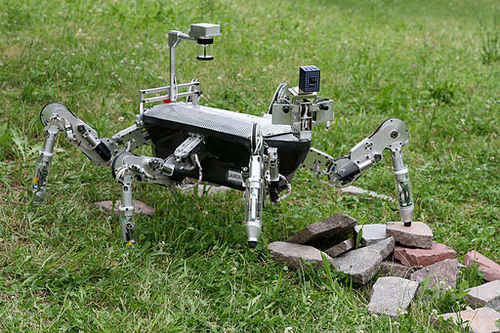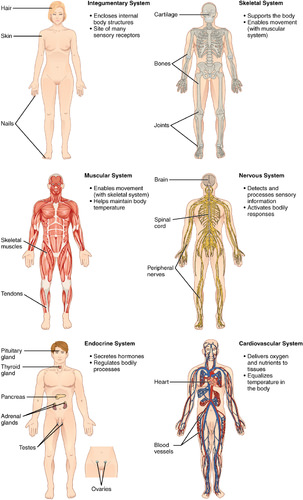9.2 机构的组织
章节大纲
-
A Fantastic Machine
::神奇机器This six-legged robot was created for research, but it looks like it might be fun to play with, too! It’s obviously a complex machine. Think about some other, more familiar machines, such as power drills, washing machines, and lawn mowers. Each machine consists of many parts, and each part does a specific job, yet all the parts work together to perform certain functions. Many people have compared the human body to a machine, albeit an extremely complex one. Like real machines, the human body also consists of many parts that work together to perform certain functions. In th is case , these parts and functions keep the organism alive. The human body may be the most fantastic machine on Earth, as you will discover when you learn more about it in this concept.
::这六条腿的机器人是用来进行研究的, 但是它看起来似乎也很有趣。 它显然是一个复杂的机器。 想想其他一些更熟悉的机器, 比如电钻、洗衣机和割草机。 每台机器由许多部件组成, 每一个部件都有特定的工作, 但所有部件都一起工作来履行某些功能。 许多人将人体与机器相比, 尽管是一个极其复杂的机器。 和真正的机器一样, 人体也包含许多部分, 一起工作来履行某些功能。 在这种情况下, 这些部件和功能可以保持生物体的活力。 人体可能是地球上最神奇的机器, 当你从这个概念中了解更多的时候, 你会发现这一点。What the Human Machine Can Do
::人类机器能做什么Imagine a machine that has all of the following attributes.
::想象一个机器 具有以下所有属性。-
It can generate a “wind” of 166 km/hr (100 mi/hr).
::它可产生每小时166公里(100毫米/小时)的“风”。 -
It can relay messages faster than 400 km/hr (249 mi/hr).
::它能够传送速度超过400公里/小时(249米/小时)的信息。 -
It contains a pump that moves about a million barrels of fluid over its lifetime.
::它含有一个泵 在其一生中移动了大约100万桶液体 -
It has a control center that contains billions of individual components.
::它有一个控制中心, 包含数十亿个单个部件。 -
It can
repair itself, if necessary.
::如有必要,它可以自行修复。 -
It may
not wear out for up to a century or more.
::它可能不会耗尽长达一个世纪或更长的时间。
This machine has all of these abilities, and yet it consists mainly of . What is it? It is the human body.
::这个机器拥有所有这些能力, 但它主要由它构成。它是什么?它是人的身体。Organization of the Human Body
::人权机构的组织The human body is a complicated, highly organized structure that consists of trillions of parts that function together to achieve all the functions needed to maintain life. The biology of the human body incorporates the body’s structure — the study of which is called anatomy — and the body’s functioning, the study of which is called physiology .
::人体是一个复杂、组织严密的结构,由数万亿个部分组成,它们共同发挥作用,实现维持生命所需的所有功能。 人体的生物学包含身体的结构 — — 其研究称为解剖 — — 和身体的功能,其研究称为生理学。The organization of the human body can be seen as a hierarchy of increasing size and complexity, starting at the level of atoms and molecules, and ending at the level of the entire organism, which is an individual living thing. You can see the intervening levels of organization in the diagram . Read about the levels in the sections that follow.
::人体的组织可被视为一个规模和复杂性不断增大的等级,从原子和分子的层次开始,到整个生物体的层次,这是个个体生物。您可以在图表中看到组织的干预级别。阅读以下各节的层次。This diagram shows the levels of organization of the human body, from atoms to the whole organism.
::本图显示人体组织层次,从原子到整个生物体。Cells
::单元格单元格The basic units of structure and function of the human body — as in all living things — are . B y the time the average person reaches , their body has an amazing 37 trillion of them! Each cell carries out basic life processes that allow the body to survive. In addition, most human cells are specialized in structure and function to carry out other specific roles. In fact, the human body may consist of as many as 200 different types of cells, each of which has a special job to do. Just a few of these different human cell types are pictured in the figure . The cells in the figure have obvious differences in structure that reflect their different functions. For example, nerve cells have long projections sticking out from the body of the cell. These projections help them carry electrical messages to other cells.
::人类身体的基本结构和功能单位——与所有生物一样——是。在普通人到达时,其身体有惊人的37万亿个。每个细胞都开展基本生命过程,使身体得以生存。此外,大多数人类细胞在结构和功能上都具有专长,可以发挥其他特定的作用。事实上,人体可能由多达200种不同类型的细胞组成,每个细胞都有特殊的任务。图中只描绘了这些不同的人类细胞种类中的少数几类。图中的细胞在结构上明显存在差异,反映了它们的不同功能。例如,神经细胞从细胞体中长长的预测显示出来,这些预测有助于它们向其他细胞传递电子信息。A few of the many different types of cells in the human body are illustrated here. Each type of cell is specialized for a particular role in the body.
::这里举例说明人体中许多不同类型的细胞中的少数几类,每一种细胞都专门为身体中某一特殊角色而专门设计。Tissues
::组织组织The next level of organization in the human body is tissues . A tissue is a group of connected cells that have a similar function. There are four basic types of human tissues: epithelial, muscle, nervous, and connective tissues . These four tissue types (shown in the figure ) make up all the organs of the human body.
::人体的下一个层次组织是组织。一个组织是一组具有类似功能的相连细胞。有四种基本人体组织类型:上皮组织、肌肉组织、神经组织以及连接组织。这四种组织类型(如图所示)构成人体的所有器官。The human body contains these four types of tissues.
::人体包含这四种组织Organs and Organ Systems
::和机关和机关系统O rgans are the next level of organization of the human body. An organ is a structure that consists of two or more types of tissues that work together to do the same job. Examples of include the heart, brain , lungs , skin, and . Human organs are organized into organ systems , which are shown in the figure below. An organ system is a group of organs that work together to carry out a complex overall function. Each organ of the system does part of the larger job.
::人体器官是人体的下一个层次的组织。器官是由两种或两种以上的组织组成的结构,它们一起工作,从事同样的工作。例如心脏、大脑、肺、皮肤等。人体器官被组织成器官系统,如下图所示。器官系统是由一组机关组成的,它们一起工作,履行复杂的整体功能。系统每个机关都承担更大的部分任务。The human organ systems. Some of the system names shown in this illustration differ from the terminology used in this book, but the systems are the same.
::人体器官系统。本插图中显示的一些系统名称不同于本书中使用的术语,但这些系统是相同的。A Well-Oiled Machine
::井水机All of the organs and organ systems of the human body normally work together like a well-oiled machine, because they are closely regulated by the nervous and endocrine systems. The controls virtually all body activities, and the secretes that help to regulate these activities. Functioning together, the organ systems supply with all the substances they need and eliminate their wastes. They also keep temperature, pH, and other conditions at just the right levels to support life.
::人体的所有器官和器官系统通常都像一个油污良好的机器一样一起工作,因为它们受到神经和内分泌系统的严格控制。它们几乎控制着所有身体活动和有助于管理这些活动的秘诀。它们一起运作,器官系统提供它们需要的所有物质并消除它们的废物。它们还将温度、pH值和其他条件保持在支持生命的适当水平上。Summary
::摘要-
The human body is like an extremely complex machine. It consists of multiple parts that function together to maintain life. The biology of the human body incorporates the body’s structure (or anatomy) and the body’s functioning (or physiology).
::人的身体就像一个极其复杂的机器。 它由多个部分组成,它们共同运作以维持生命。 人体的生物学包含身体的结构(或解剖学 ) 和身体的功能(或生理学 ) 。 -
The organization of the human body is a hierarchy of increasing size and complexity, starting at the level of atoms and molecules, and ending at the level of the entire organism.
::人体的组织是一个规模和复杂性越来越大的等级,从原子和分子的层次开始,到整个生物体的层次结束。 -
Cells are the level of organization above atoms and molecules, and they are the basic units of structure and function of the human body. Each cell carries out basic life functions, as well as other specific roles. Variations in cell function are generally reflected in variations in cell structure.
::细胞是原子和分子以上的组织层次,它们是人体结构和功能的基本单位,每个细胞发挥基本的生命功能和其他特定作用,细胞功能的变化一般反映在细胞结构的变化中。 -
The next level of organization above cells is the tissue. A tissue is a group of connected cells that have a similar function. There are four basic types of human tissues: epithelial, muscle, nervous, and connective tissues. These four types of tissues make up all the organs of the human body.
::细胞上下一级组织是组织。组织是一组具有类似功能的相连细胞。人类组织有四种基本类型:上皮、肌肉、神经和连接组织。这四种类型的组织构成人体的所有器官。 -
The next level of organization above tissues is the organ. An organ is a structure that consists of two or more types of tissues that work together to do the same job. Examples include the brain and heart.
::组织上下一级组织是器官。一个器官是由两种或两种以上的组织组成的结构,它们共同工作,从事同样的工作。例如大脑和心脏。 -
Human organs are organized into organ systems. An organ system is a group of organs that work together to carry out a complex overall function. For example, the skeletal system provides structure to the body and protects internal organs.
::人体器官组织成器官系统,器官系统是一组合力履行复杂整体功能的机关,例如,骨骼系统为人体提供结构,保护内部器官。 -
All of the organs and organ systems of the body normally work together like a well-oiled machine, because they are closely regulated by the nervous and endocrine systems.
::人体的所有器官和器官系统通常都像一个油污良好的机器一样一起工作,因为它们受到神经和内分泌系统的严格控制。
Review
::回顾1. How is the human body like a complex machine?
::1. 人体如何像一台复杂的机器?2. Compare and contrast human anatomy and human physiology.
::2. 比较和对比人体解剖学和人体生理学。3. Summarize the hierarchical organization of the human body.
::3. 概述人体的等级结构。4. Relate cell structure to cell function, and give examples of specific cell types in the human body.
::4. 将细胞结构与细胞功能联系起来,并举例说明人体中具体的细胞类型。5. Define tissue, and identify the four types of tissues that make up the human body.
::5. 确定组织,确定构成人体的四种类型的组织。6. What is an organ? Give three examples of organs in the human body.
::6. 什么是器官?举人体器官的三个例子。7. Define organ systems. Name five examples in the human body.
::7. 界定器官系统,列举人体的五个例子。8. How is the human body regulated so all of its organs and organ systems work together?
::8. 如何规范人体,使其所有器官和器官系统携手合作?9. True or False: Organs consist of one or more types of tissue.
::9. 真或假:器官由一种或多种组织组成。10. True or False: The way that cells use oxygen is an example of physiology.
::10. 真实或假:细胞使用氧气的方式是生理学的一个例子。11. The organ system that secretes hormones is called the _______________ system.
::11. 分泌荷尔蒙的器官系统称为系统。12. A neuron is a ___________________.
::12. 神经元是。a. specialized cell
::a. 专门单元b. unspecialized cell
::b. 非专门单位c. an organ
::c. 机关d. an organ system
::d. 机关系统13. Which organ system’s function is to provide structure to the body and protect internal organs?
::13. 哪个机关系统的职能是为机关提供结构并保护内部机关?14. Give one example of how the respiratory and circulatory systems work together.
::14. 举一个例子说明呼吸和循环系统是如何共同工作的。15. The human body has as many as _________ types of cells.
::15. 人体的细胞种类多达______。a. four
::a. 4个b. 20
::b. b. 20c. 137
::c. 137项d. 200
::d. 200Explore More
::探索更多The human body consists of more than just human cells, tissues, organs, and organ systems. It also includes a huge number of single-celled organisms that live inside the body and have a great and largely unexplored role in our health. You can learn more about the three pounds of microbes that you carry around with you by watching this TED talk:
::人体不仅包括人体细胞、组织、器官和器官系统,还包括大量单细胞生物,它们生活在人体内,在我们的健康中具有巨大和基本上未探索的作用。通过观看TED的演讲,你可以学到更多关于你随身携带的三磅微生物的知识:Ever wish you were as smart as a computer? Well, engineers wish they could build computers as smart as you! Learn more here:
::工程师希望他们能像你一样造电脑! -
It can generate a “wind” of 166 km/hr (100 mi/hr).





